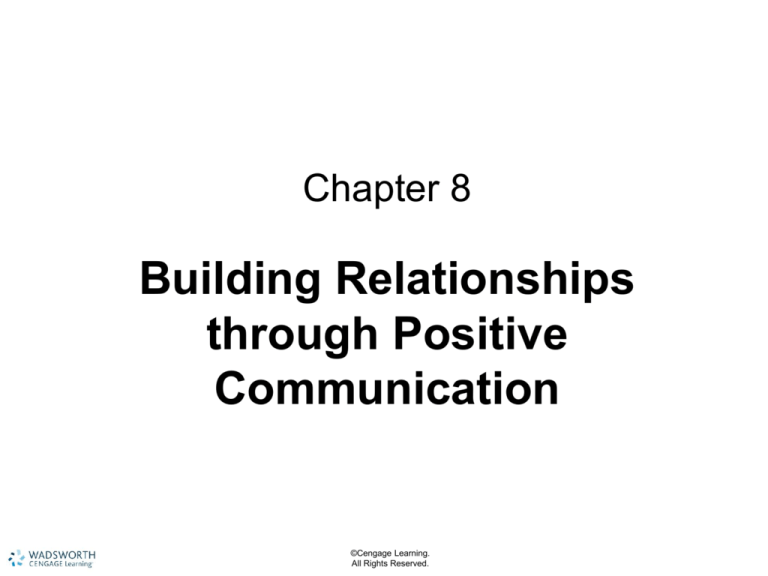
Chapter 8
Building Relationships
through Positive
Communication
©Cengage Learning.
All Rights Reserved.
©Cengage Learning.
All Rights Reserved.
Communication skills are
developed early in life
• Adults influence children by…
–Setting a good example for them
–Encouraging them to practice
appropriate communication skills
–Listening to them
©Cengage Learning.
All Rights Reserved.
Effective Listening
• Auditory physiology
–Physical makeup of the ear that
enables hearing
–Sounds channeled through external
auditory canal to the tympanic
membrane (eardrum) and middle ear
(ossicles) and then through auditory
nerve to the brain for interpretation
©Cengage Learning.
All Rights Reserved.
Effective Listening (continued)
• Auditory perception
–Ability to understand what has
been heard
©Cengage Learning.
All Rights Reserved.
Effective Listening (continued)
• Osmosis
– Tendency of fluids to gradually flow through
absorbent material
• Young child’s “absorbent mind”
– Gradual, often unconscious mental process of
assimilating concepts
– Absorbing information in a way that resembles
osmosis
©Cengage Learning.
All Rights Reserved.
©Cengage Learning.
All Rights Reserved.
Effective Listening
(continued)
• Active listening
– Form of attentive listening in which one
concentrates on what is being said
– Reflecting ideas back to the speaker to confirm
understanding
• Mirroring
– Reflecting back the feelings expressed by
someone else
– Repeating what you understood
©Cengage Learning.
All Rights Reserved.
Underlying Feelings
• Emotions may
unconsciously trigger
inappropriate behavior
• Feelings must be
considered to provide
appropriate responses
to behaviors
• Adults can help
children understand the
motives for their
misbehaviors
©Cengage Learning.
All Rights Reserved.
Addressing Underlying Feelings
• Before you can really help someone,
you must understand that person’s
underlying request
–Action?
–Information?
–Understanding and attention?
–Inappropriate interaction?
©Cengage Learning.
All Rights Reserved.
Remember…
• Responsive and active listening
is an integral part of child
guidance
• Dependency and inappropriate
interaction must be firmly and
respectfully redirected
©Cengage Learning.
All Rights Reserved.
Positive Instructions Versus
Negative Commands
• Positive instructions are constructive,
affirmative statements of desired or
expected behaviors
• Negative commands are disapproving
statements of what behaviors are not
desired or expected
• Positive instructions are more effective
than negative commands
©Cengage Learning.
All Rights Reserved.
Characteristics of
Assertive Communication
• Assertive communication
– Provides firm, confident statements; is
persistently positive
– Is honest, but not brutal
– Requires respect and empathy to be effective
• Empathy shows understanding and compassion
• Concrete means specific and focused; it is the
opposite of abstract or general
©Cengage Learning.
All Rights Reserved.
Say What You Mean—
Mean What You Say
• Ask a question only if the child really has a choice
– “Would you like something to drink?”
• State choices if the child will be allowed to choose
– “Would you rather have apple juice or milk?”
• If something must happen, do not discuss it forever
– “You must take your medicine so that your cough will
get better"
©Cengage Learning.
All Rights Reserved.
Adults Influence Children
• Adults should set a good example for children
• Adults should encourage children to practice
appropriate communication skills
©Cengage Learning.
All Rights Reserved.
Developing Responsibility
• Adults help children develop
responsibility
–By encouraging children to talk
about potential consequences
of behavior
©Cengage Learning.
All Rights Reserved.
Managing the
Positive Confrontation
• Adults often avoid, squelch, dismiss, or
deny negative feelings
• Tactics that avoid addressing feelings
are ineffective and harmful to open,
honest communication
• Positive confrontation is a healthy and
natural part of social interaction
©Cengage Learning.
All Rights Reserved.
Be assertive
• Assertiveness always requires
respect and empathy to be
effective
• Evasive tactics are ineffective
and harmful to open, honest
communication
©Cengage Learning.
All Rights Reserved.
Adults can assist children in
developing responsibility by
encouraging them to think and talk
about potential consequences of
their behavior
©Cengage Learning.
All Rights Reserved.
Exploring Consequences
• Logical consequences that are not
dangerous or unreasonable provide
children useful feedback on the
appropriateness of their behavior.





